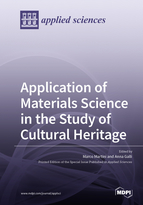Application of Materials Science in the Study of Cultural Heritage
A special issue of Applied Sciences (ISSN 2076-3417). This special issue belongs to the section "Materials Science and Engineering".
Deadline for manuscript submissions: closed (15 February 2022) | Viewed by 14476
Special Issue Editors
Interests: radiation effects in insulators and dosimetric materials; physics applied to the cultural heritage; development and application of techniques for luminescence and radiocarbon dating
Interests: physics applied to cultural heritage; archaeometry; TL dating; OSL dating X-ray fluorescence; ancient material characterization
Special Issues, Collections and Topics in MDPI journals
Special Issue Information
Dear Colleagues,
The application of advanced techniques to the study of ancient materials has increasingly led to a range of fundamental to deeper knowledge of artistic and historic artefacts, contributing to their conservation and restoration. The number of scientific methodologies applied to cultural heritage is huge and difficult to list. However, it can be noted that an important role is played by materials science: scientific techniques developed in materials science allow a multidisciplinay approach in archaeology, history of art, and conservation. By studying the materials that constitute an artefact, a greater amount of information can be accessed, relatively to the work of art, such as the elements and compounds with which it was made and their level of degradation by the time of the examination. The final goal is the possibility of determining the chronology of the making of the various parts of the work of art, its provenance, the techniques of realization, the attribution to an author, and the way of intervention for restoration. Materials science offers many different scientific methodologies in order to investigate ancient materials and artefacts.
This Special Issue is intended to collect papers dealing with the applications of materials science to the different types of human artefacts such as ceramic, glass, paintings, and metals objects. The considered topics can range from instrumentation and technical developments to case studies and methodological innovations, from theoretical simulations to new data handling. All the characteristic analytical methods of materials science will be considered: imaging techniques (IRR, RX, tomography); traditional as well as innovative dating techniques such as luminescence (TL, OSL, RL (radioluminescence)), radiocarbon, RHX (re-hydroxylation); and spectroscopic techniques (PIXE, Raman, FTIR, UV-vis reflectance spectroscopy) and their synergic association.
Prof. Dr. Marco Martini
Dr. Anna Galli
Guest Editors
Manuscript Submission Information
Manuscripts should be submitted online at www.mdpi.com by registering and logging in to this website. Once you are registered, click here to go to the submission form. Manuscripts can be submitted until the deadline. All submissions that pass pre-check are peer-reviewed. Accepted papers will be published continuously in the journal (as soon as accepted) and will be listed together on the special issue website. Research articles, review articles as well as short communications are invited. For planned papers, a title and short abstract (about 100 words) can be sent to the Editorial Office for announcement on this website.
Submitted manuscripts should not have been published previously, nor be under consideration for publication elsewhere (except conference proceedings papers). All manuscripts are thoroughly refereed through a single-blind peer-review process. A guide for authors and other relevant information for submission of manuscripts is available on the Instructions for Authors page. Applied Sciences is an international peer-reviewed open access semimonthly journal published by MDPI.
Please visit the Instructions for Authors page before submitting a manuscript. The Article Processing Charge (APC) for publication in this open access journal is 2400 CHF (Swiss Francs). Submitted papers should be well formatted and use good English. Authors may use MDPI's English editing service prior to publication or during author revisions.
Keywords
- Cultural heritage
- Materials science
- Spectroscopy
- Luminescence dating
- Thermoluminescence
- Radiocarbon
- IR spectroscopy
- X-ray radiography
- Raman
- FTIR
- PIXE







